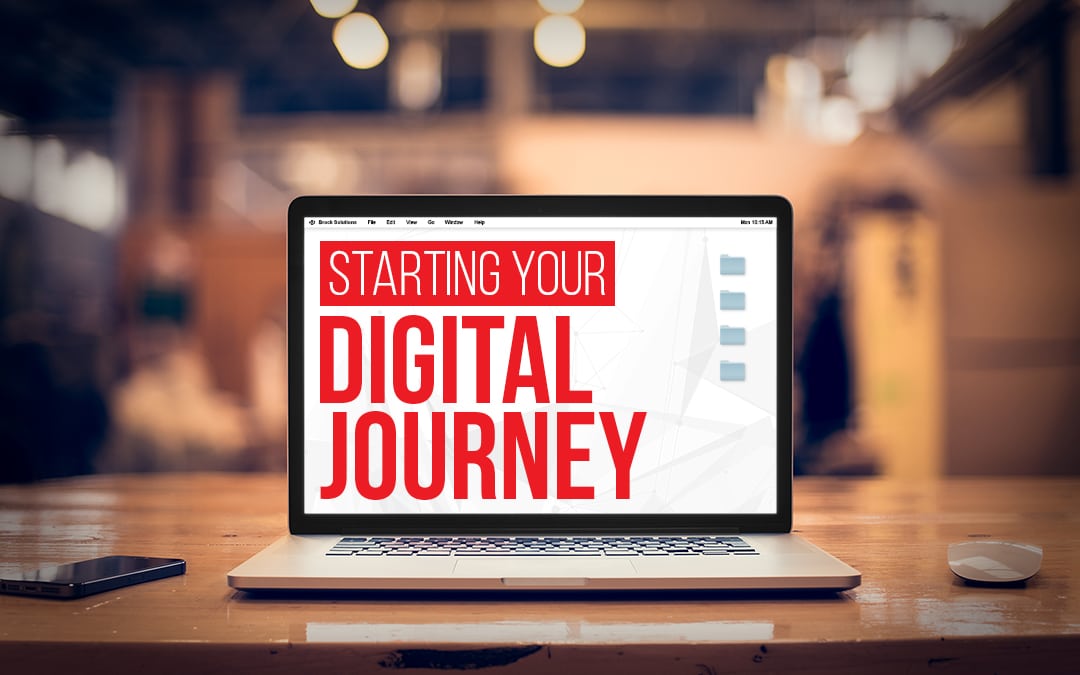The final installment of Brock Solutions’ Critical Success Factors for the Digital Journey series – Getting Started is not as daunting as it may seem…
A week doesn’t go by without someone asking me something about Digital – Digital thread, digitization, and its buzzword offspring IoT, IIoT, SmartManufacturing, MOM/MES, Edge devices, IT/OT LMNOP…
At the heart of most of the questions, however, is a basic desire to do something…anything…that will make Operations more profitable and keep competitors at bay. And a growing sensibility that it’s now or never; “if we don’t embrace digital, if we don’t have real-time visibility, if we keep managing our ops through spreadsheets and smart, experienced people, we’re in big trouble.”
The pain is real and the desire to get going is almost unanimous across functional areas when we talk with manufacturers. So, what’s holding them back?
Time after time, the number one issue I hear is “We don’t know how to get started.”
This blog post will share our experiences tackling that issue and highlight some ideas that can help.
A typical conversation with folks struggling to get started goes something like this:
- We’re running much of our operations on spreadsheets, custom systems and internal knowledge. There, but for the grace of Excel, go I….
- We tried implementing digital MES-type solutions before and it was a minor disaster. We put the brakes on after a couple pilots and need to regroup and do it right.
- We’re pretty confused about the space and all the moving pieces. And we spend a lot of money on ERP which seems somehow munged together in this space.
- Is there really a $$ return? Soft benefits are nice, but we need to see real results.
- We need help figuring it out, but we don’t know who to turn to or trust.
Those might seem like big, overwhelming issues, but from our experience are exactly the right things to worry about. Taking a step back to understand requirements, return on investment, and a realistic roadmap is how we recommend getting started. And not in an academic way – however these questions get answered, they need to be based on the practical realities of $, plant-readiness and business priorities.
When we get engaged to help manufacturers with digital strategies, we often deliver a package we call a “Framework Study”. It has three key deliverables:
- Workflows: These are graphical representations of requirements and system interactions. They answer the question of “what do we need, and what goes where?” This is the heart of any strategy we deliver.
- Business Case: In an earlier blog post, Greg Cantlon from Brock Solutions shared how these are pulled together and what they look like. In our experience, the business case is absolutely fundamental to any digital strategy. It clearly defines the value and expected return against the cost. It drives alignment. And at the end of the day it’s a requirement to advance the program.
- Roadmap: Based on the business case and workflows, we generate a roadmap for implementation. The typical timeline is 3-5 years but includes enough detail to get started on something meaty in year one. The roadmap tackles tough questions like ‘do we do everything in one plant first, and then roll out? Is it better to do a slice of functionality across all our plants?’
The folks at Brock Solutions that lead these engagements have lived through successful, and to be honest, not-so-successful digital/MES/MOM programs so they have the real experience to ask the right questions and guide the process. They speak up when things don’t look right, or if they see red flags that could get in the way of success. There are a couple key things that make the whole Framework Study process successful:
- Executive Engagement: If your execs aren’t aligned on the importance of the study and on the idea that it is the first, key step in your transformational journey, we recommend that you don’t do it at all. Full stop.
- Cross-Functional Core Team that Gets It: When figuring out requirements, roadmap, and return, the reality is you need the right people in the room that understand how your business works, where things could be better, and what’s realistic in terms of ROI. The best core teams we’ve worked with represent multiple parts of the business (Ops, Engineering, QA, Maintenance, IT, Finance), are passionate about improving and are empowered by leadership.
These Framework Study engagements aren’t typically that long in duration; 8-12 weeks is the norm. And that timeline is by design – if defining the strategy takes more than 3 months the dreaded analysis-paralysis sets in and momentum grinds to a halt…
Framework Studies are not for everyone. Many of our customers are already down the digital path and look to us to deliver and sustain their solutions. But for those that need help figuring out how to get started, we’re happy to engage and share our approach. It’s based on a couple well-honed tools like workflows and business case templates, and 30 years’ experience from the school of hard knocks.
We chose the topic of a Framework Study as the close to our Critical Success Factors for the Digital Journey series because it neatly packages up many of the elements we believe are required for a digital transformation:
If you’d like to learn more about what makes up a Framework Study, including workflow examples, watch this video on How to Get Started with MES. If you’d like to see what an actual Framework Study deliverable looks like, contact us and we’d be happy to walk you through a couple of samples.

